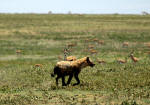Serengeti National Park, Tanzania
Plain in north-central Tanzania best known for its huge herds of plains animals, and the only place in Africa where vast land-animal migrations still take place. The park was established in 1951 and covers 14,763 square km of some of the best grassland range in Africa, as well as extensive acacia woodland savanna; elevations range from 920 to 1,850 m. Within the area are nearly 1,300,000 wildebeest, 60,000 zebras, 150,000 gazelles, and numerous other animals. During the wet season, from November to May, the herds graze in the southeastern plains within the park. In late May or June one major group moves west into the park's woodland savanna and then north into the grasslands just beyond the Kenya-Tanzania border, an area known as the Mara. Another group migrates directly northward. The herds return to the park's southeastern plains in November, at the end of the dry season.
In addition to more than 35 species of plains animals, there are some 3,000 lions and great numbers of spotted hyenas, leopards, rhinoceroses, hippopotamuses, giraffes, cheetahs, and baboons. Crocodiles inhabit the marshes near the Mara River. More than 350 species of birds, including ostriches, vultures, and flamingos, have also been recorded. Elephants arrived in the park only in recent decades as human populations and agriculture expanded outside; their population is estimated at some 1,360. The last of the Serengeti's wild dogs disappeared in 1991; it is possible that unvaccinated domestic dogs spread rabies to the wild dogs, resulting in their local extinction. An epidemic of canine distemper caused the deaths of nearly one-third of the area's lions in 1994. The killing of elephants for their ivory tusks, the slaughter of the now virtually extinct black rhinoceros for its horn (which is prized in Yemen for dagger handles), and the poaching of game animals for meat-an estimated 200,000 a year-are major threats.
The first systematic wildlife population survey in the area was undertaken by the German zoologist Bernhard Grzimek in the late 1950s. The park's headquarters are near its centre, at Seronera, where the Seronera Wildlife Research Centre (established as the Serengeti Research Institute, 1962) is also based. [- Adapted from Encyclopedia Britannica, 2004.]
Designed in collaboration with Vitalect, Inc. All rights reserved. |








































































